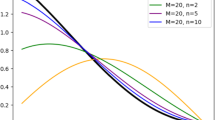Abstract
We consider an application of optimal control theory to a marketing problem, in which a firm seeks the maximum profit by producing and selling a seasonal product. We assume that the firm can advertise its product in order to improve the firm goodwill and affect the product demand positively. In particular the demand is zero when the goodwill is less than a fixed threshold. The original optimal control problem is shown to be equivalent to a nonlinear programming problem, which has an optimal solution, possibly not unique.
Similar content being viewed by others
References
Clarke, F.,Optimization and Nonsmooth Analysis, Canadian Mathematical Society: New York, 1983.
Clarke, F.,Methods of Dynamics and Nonsmooth Optimization, CBMS-NSF Regional Conference Series in Applied Mathematics: Philadelphia, 1989.
Dockner, E., Jørgensen, S., “Optimal advertising policies for diffusion models of new product innovation in monopolistic situations,”Management Science, vol. 34, pp. 119–130, 1988.
Dorfman, R., Steiner, P. O., “Optimal advertising and optimal quality,”American Economic Review, vol. 44, pp. 826–836, 1954.
Favaretto, D., Viscolani, B., “Controllo ottimo di produzione e comunicazione per un prodotto stagionale,”Rendiconti del Comitato per gli Studi Economici, vol. XXX-XXXI, pp. 209–225, 1993.
Favaretto, D., Viscolani, B.,Determining optimal production and advertising policies for a seasonal product, submitted to European Journal of Operational Research.
Hahn, M., Hyun, J. S., “Advertising cost interaction and the optimality of pulsing,”Management Science, vol. 37, pp. 157–169, 1991.
Intriligator, M. D.,Mathematical Optimization and Economic Theory, Prentice-Hall: Englewood Cliffs, 1971.
Little, J. D. C., “Aggregate advertising models: the state of the art,”Operations Research, vol. 27, pp. 629–667, 1979.
Luenberger, D. V.,Linear and Nonlinear Programming, Addison Wesley: Reading, 1984.
Nerlove, M., Arrow, K. J., “Optimal advertising policy under dynamic conditions,”Economica, vol. 29, pp. 129–142, 1962.
Sasieni, M. W., “Optimal advertising expenditure,”Management Science, vol. P18, pp. 64–72, 1971.
Seierstad, A., Sydsaeter, K.,Optimal Control Theory with Economic Applications, North-Holland, Amsterdam, 1987.
Spremann, K., “The signaling of quality by reputation,” in G. Feichtinger (ed.),Optimal Control Theory and Economic Analysis 2, North Holland, Amsterdam, pp. 235–252, 1985.
Teng, J. T., Thompson, G. L., “Optimal strategies for general price-advertising models,” in G. Feichtinger (ed.),Optimal Control Theory and Economic Analysis 2, North Holland, Amsterdam, pp. 183–195, 1985.
Vidale, M. L., Wolfe, H. B., “An operations research study of sales response to advertising,”Operations Research, vol. 5, pp. 370–381, 1957.
Viscolani, B.,Optimal advertising for selling a product with a nondifferentiable demand function, Rivista di Matematica per le Science Economiche e Sociali, vol. 17, pp. 53–56, 1996.
Author information
Authors and Affiliations
Additional information
Editor: G. Leitmann
Rights and permissions
About this article
Cite this article
Favaretto, D., Mazzega, P., Mezzaroba, A. et al. Optimal control of advertising and production of a seasonal product with nondifferentiable demand. Dynamics and Control 6, 91–104 (1996). https://doi.org/10.1007/BF02169463
Received:
Issue Date:
DOI: https://doi.org/10.1007/BF02169463



